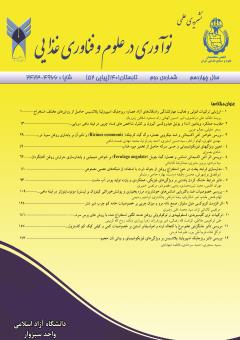ارزیابی ترکیبات فنولی و فعالیت مهارکنندگی رادیکالهای آزاد عصاره ریزجلبک اسپیرولینا پلاتنسیس حاصل از روشهای مختلف استخراج
محورهای موضوعی : روشهای استخراج ترکیبات موثرهپریسا دلفان 1 , علی مرتضوی 2 , امیر حسین الهامی راد 3 , مسعود شفافی زنوزیان 4
1 - گروه علوم وصنابع غذایی، واحد سبزوار، دانشگاه آزاد اسلامی،سبزوار، ایران.
2 - گروه علوم وصنابع غذایی، واحد سبزوار، دانشگاه آزاد اسلامی،سبزوار، ایران.
3 - گروه علوم وصنابع غذایی، واحد سبزوار، دانشگاه آزاد اسلامی،سبزوار، ایران.
4 - گروه علوم وصنابع غذایی، واحد سبزوار، دانشگاه آزاد اسلامی،سبزوار، ایران.
کلید واژه:
چکیده مقاله :
در این پژوهش، عصاره ریز جلبک اسپیرولینا پلاتنسیس با سه روش خیساندن، مایکروویو و فراصوت و با استفاده از دو حلال آب و اتانول تحت شرایط کنترل شده استخراج شد و ارزیابی میزان فلاونوئید، میزان فنول کل و ظرفیت آنتیاکسیدانی (IC50) عصارههای حاصل به ترتیب بر اساس روش رنگی آلومینیوم کلرید، رنگ سنجی به روش فولین ـ سیوکالتو و جذب رادیکال DPPH(۲ و ۲ دی فنیل ـ۱ـ پیکریل هیدرازیل) در سه تکرار انجام گرفت. نتایج نشان داد که بین تکنیکهای استخراج، روش فراصوت و بین دو حلال مورد استفاده، آب بهترین راندمان استخراج فنول کل، فلاونوئید و فعالیت رادیکالگیرندگی را داشت و مقادیر فنول کل، فلاونوئید و فعالیت رادیکال گیرندگی در روش فراصوت به ترتیب برابر با 36/0 ± 2.13 (mg/ml)، 35/0 ± 3.4 (mg/ml) و 35/0 ± 0.34 (µg/ml) تعیین گردید. به عنوان نتیجهگیری میتوان گفت که به کارگیری تکنیک فراصوت و حلال آب در مقایسه با پنج تیمار دیگر توانست بهترین کارایی را نشان دهد و در نهایت به عنوان تیمار بهینه انتخاب گردد.


